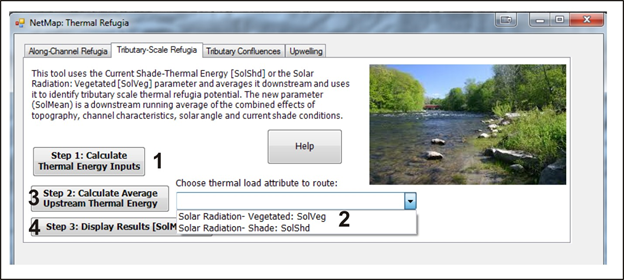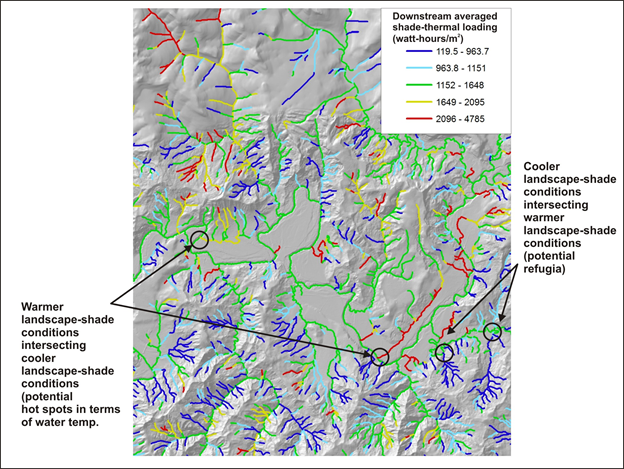| < Previous page | Next page > |
Tributary ScaleAlong Channel Thermal Refugia (tributary scale)
Tool Description: This tool uses the Current Shade-Thermal Energy parameter (SolShd) and aggregates it downstream, reporting area weighted average values of Current Shade-Thermal Energy. The new parameter (SolMean) is a downstream running average of the combined effects of topography, channel characteristics, solar angle and current shade conditions (for a more complete description of Current Shade - Thermal Energy, see that tool under 7.5).
NOTE, prior to running this tool, you will need to access and process Vegetation Data, such as LEMMA (see Tool).
Data Type: Line (stream layer)
Field Name: SolMean; Common Name: Current shade thermal energy (to streams), routed downstream and averaged (area weighted).
Units: Watt-hours/m2
NetMap Module/Tool: Vegetation/Fire/Climate - Vegetation - Shade/Stream - Thermal Refugia - Along Channel, Tributary Scale
Model Description: The model predicts thermal energy to stream channels using a combination of bare earth radiation and the effects of current shade conditions on bare earth radiation (See Current Shade-Thermal Energy tool). NetMap routes that those values downstream creating an area weighted, running average. Based on inherent topographic controls on thermal energy to streams (topographic shading, stream orientation, stream width and solar angle) and the current shade conditions that reduce thermal energy to streams, the resulting new attribute (SolMean) depicts along channel thermal conditions.
 Figure 1. (1) Calculate "Solar Radiation-Vegetated" or "Solar Radiation - Shade" if they have not previously been calculated; see links for tools. (2) Select which attribute to aggregate downsteam (known as average upstream thermal energy). (4) Display results. Examples follow using Solar radiation-shade (or called Shade-Thermal Energy).
NOTE, prior to running this tool, you will need to access and process Vegetation Data, such as LEMMA (see Tool).
Figures 2 and 3 show the values of SolMean, revealing that some tributary channels, or larger portions of them, have higher or lower aggregate thermal loading to streams. Tributary scale current shade-thermal energy can also be viewed from the perspective of larger mainstem channels. For example, which tributaries might be considered thermal refugia. To examine that feature, an analyst can examine the aggregate shade thermal loading condition at the areas of tributary confluences, to see which tributaries may be sources of cooler or water warmer. See also "Confluence Zone Refugia".
  |